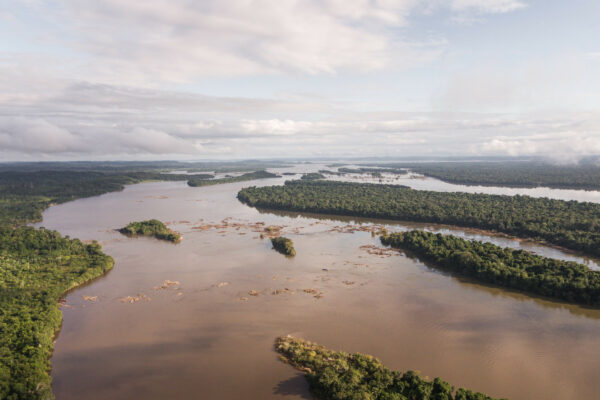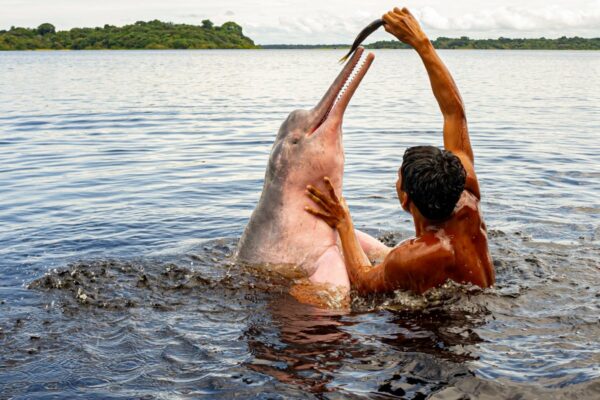American Indians of the Klamath River basin have been fighting for the removal of dams for years through protests, political pressure and public outreach.
More than 5,000 miles away in Brazil’s Amazon basin, another battle between dams and the Indians’ way of life is being waged, and a delegation of young Klamath River Indians and river activists is heading south this month to join forces.
“We’re not going to just deal with the Klamath and quit – that’s not what we’re about,” said Sammy Gensaw III, a 20-year-old Yurok tribal member who is part of the “Klamazon Delegation” heading to Brazil next week. “We’re going to help other indigenous people as well, whether they are just down the road from us or in Brazil.”
To raise funds for the trip, the Klamazon Delegation is hosting an open-mic and spoken word event from 4 to 6:30 p.m. Saturday at the Coastal Connections youth resource center, 475 K St., Crescent City. All types of performances, including spoken word, acoustic music, and hip-hop, are welcome and a complete DJ set-up will be available, Gensaw said. The “World’s best Indian tacos” will be available for purchase, and there is a $5 cover.
The Klamazon Delegation is joining the indigenous people’s resistance in the Xingu River basin, a major tributary to the Amazon River, where the proposed Belo Monte Dam project would build the world’s third-largest hydroelectric dam. The project would displace 20,000-40,000 people and flood more than 320 square miles, according to International Rivers, a Berkeley-based nonprofit environmental group that promotes dam-free rivers.
The Amazon basin, about the size of the continental U.S., is home to 60 percent of the world’s remaining rainforest, and holds one-fifth of the world’s fresh water.
Gensaw and most others in the Klamazon Delegation, which includes two adults and five youths ages 14–20, have been involved for years in activism against the relicensing of the Klamath River dams.
Last September, Gensaw was waving picket signs in front of the Portland office of Oregon U.S. Sen. Ron Wyden, who supports Klamath dam removal, just to let the senator know that the Klamath River’s Indian tribes are still waiting.
At one point during dam removal negotiations, tribal members brought samples of toxic blue-green algae, believed to multiply in the dam reservoirs, to the Portland offices of Pacific Power, which owns the dams.
Another time, activists including Nat Pennington, an Orleans-based fisheries biologist and river activist who is helping organize the Klamazon trip, protested for dam removal at a shareholder meeting in Omaha of Berkshire Hathaway, which owns Pacific Power.
Tribal members have even traveled to protest at shareholder meetings in Scotland when the Klamath dams were owned by Scottish Power.
Pennington said that the political pressure from protests and public outreach was a key force in getting all players to come to the table to create the Klamath settlement agreements that would remove four dams on the Klamath River.
“Without public pressure and political pressure through things like media outreach and public awareness campaigns we never would have been at the place where we are with the dam removal hopefully right on the horizon,” Pennington said. “I’ve done press releases that have gotten the immediate attention from the desk of Gov. Arnold Schwarzenegger.”
The Klamazon Delegation manifested when Pennington told Dania Rose Colegrove, a tribal member and river activist whom he considers one of his mentors, said that she needed a tropical vacation.
“With us both being so drawn to activism, we could not just go on vacation; we had to try to do something at the same time, and we had been following the Belo Monte Dam Resistance Delegation,” Pennington said.
Amazon Watch, a nonprofit organization that works to promote the Amazon rainforest and its indigenous people, was on board with Pennington’s idea from the start.
In addition to meeting with indigenous groups and river activists in the Amazon, the Klamazon Delegation has scheduled a meeting with the Brazilian secretary of the environment.
“We want to explain that there’s a better way to handle this situation,” said Gensaw. “Our message is basically: Don’t make the same mistake the United States did. The U.S. is going back and ripping out the same dams they put in, which is costing them way more money than the dams ever produced.”
Representatives of Amazon Watch said they plan to send a similar delegation to Northern California in the future to learn about the river and Indian concerns here and to spread the message about their struggle against the Belo Monte project.
“Our river is here to give us life, and we were created to keep the river beautiful and healthy. We need to keep every river alive because we cannot live without them,” said Mahlija Florendo, a 16-year-old Yurok tribal member who will be going to the Amazon. “The Amazon River is a huge bloodline for life of the Amazon indigenous as the Klamath is ours.”













